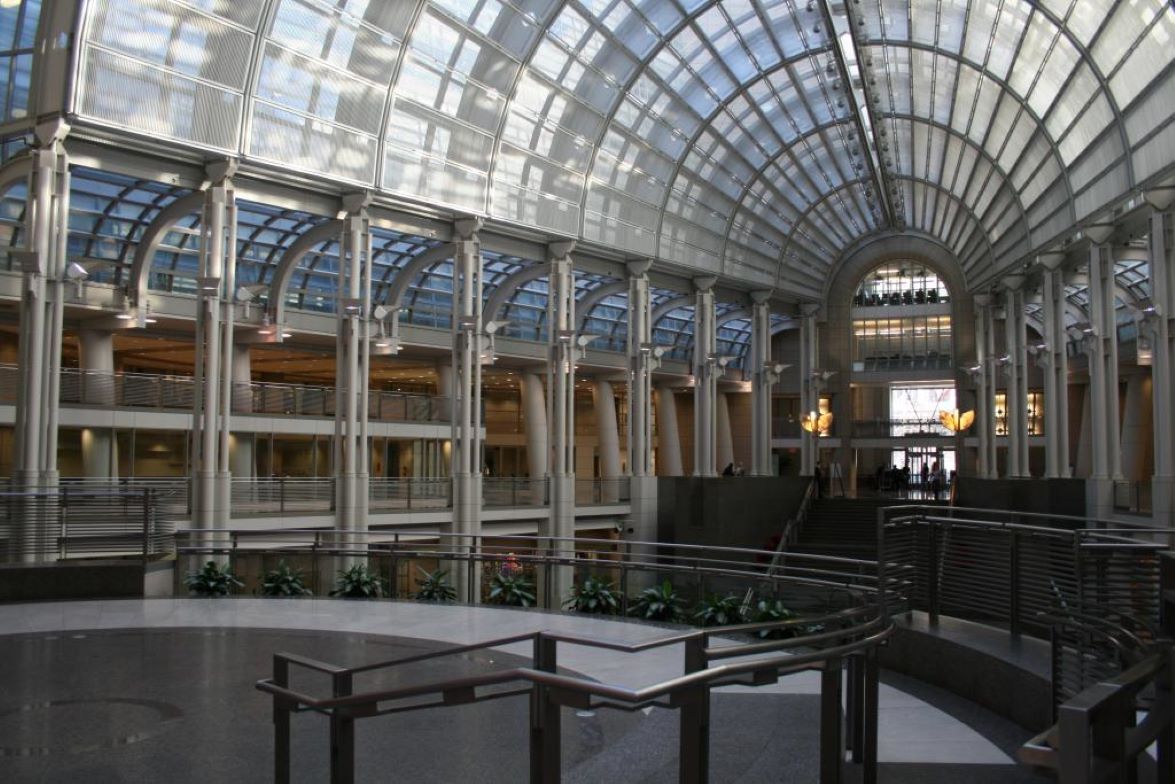
GSA makes electrifying move at Ronald Reagan Building and International Trade Center
The Ronald Reagan Building and International Trade Center in the nation’s capital is a palace among federal buildings. It holds more than 3 million square feet of office space – making it second only to the Pentagon in size in the region – and features a cavernous, glittering atrium at its entrance.
Few people visiting for the first, second or even 10th time can’t avoid looking up as escalators move them down to the center hallway where major conferences and trade shows have been held under the skylights. The landmark property houses federal offices, private office suites, high-visibility showcase and retail spaces, and a full-service conference center with 22 event spaces.
And for both in-the-know federal workers and tired, hungry tourists, the Ronald Reagan Building and International Trade Center’s food court offers sanctuary on a hot and muggy or bitterly cold Washington day.
GSA has chosen the building for an equally massive update, this one around sustainability and decarbonization, by taking the building 100% electric.
“At GSA, we’ve already reduced greenhouse gas emissions in our federal footprint building by more than half,” said GSA Administrator Robin Carnahan at an event announcing $975 million from the Inflation Reduction Act for energy and cost-saving investments in over 100 buildings nationwide. “We’ve already managed to save taxpayers $638 million dollars by making smart investments. It’s our plan to do more of that moving forward.”
First of many to go electric
Why this effort now? To reduce the fuel and costs it takes to control the building’s heating and cooling. The electrification of the Ronald Reagan Building alone will save over $6.3 million in energy costs annually and reduce emissions by 16,000 tons. The $975 million will impact about 40 million square feet of GSA’s buildings portfolio.
The U.S. Agency for International Development, one of the building’s largest tenants and home to that agency’s headquarters, participated in the June 20 event and made strong commitments of its own.
“Our climate strategy commits USAID to transforming the agency’s operations so as to minimize our contributions to climate change,” said Paloma Adams-Allen, USAID’s Deputy Administrator for Management and Resources. “This includes working to reduce emissions from our facilities, our vehicle fleets, our business travel, our acquisitions assistance processes, our supply chains, our utility consumption, waste management and information technology processes,” efforts which GSA supports in many direct and indirect ways.
According to GSA, over the next three years, eliminating Scope 1 emissions — the greenhouse emissions associated with fuel combustion in boilers and furnaces — will be realized by upgrading to all-electric heat pumps at the Ronald Reagan Building. The pumps will use steam to heat spaces and water.
They will also replace chillers – the cooling part of air conditioners – and upgrade LED lights, which are safer, sturdier, longer lasting and more energy efficient, according to Energy.gov. GSA will also install devices to monitor and regulate utilities efficiently, as well as analyze and guide how to maximize savings.
Driving to net-zero
The effort comes thanks to the President’s Investing in America Agenda and advances the goal to achieve net-zero emissions in the federal buildings by 2045. Net zero is a sustainability target that means our buildings will produce as much energy as they consume.
Through the Inflation Reduction Act, GSA received $975 million to upgrade federal buildings with emerging and sustainable technologies that will accelerate our drive toward net zero. That investment will save more than 2.3 million metric tons of greenhouse gas emissions from being released into the atmosphere. That’s the equivalent of taking 511,820 gas-powered vehicles off the road for a year. The agency expects to more than double its $975 million investment and distribute nearly $2 billion in private and public funding.
Over the lifecycle of the investment, GSA projects in today’s money:
- Adding 5,000 jobs and $2.4 billion into the U.S. economy.
- Saving an estimated $467 million in energy costs.
More jobs equals more money in the pockets of Americans, and perhaps more lunches for the people who work in and visit the Ronald Reagan Building and International Trade Center’s food court. Just save us a seat, please.

 U.S. General Services Administration
U.S. General Services Administration
